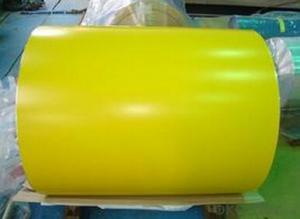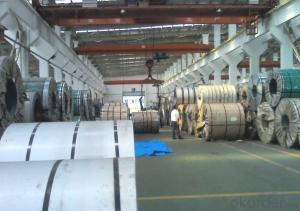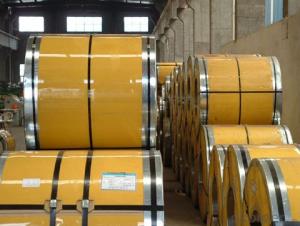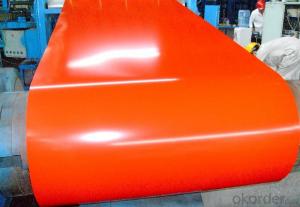Best Prepainted Galvanized steel Coil ASTM 615-009
- Loading Port:
- Tianjin
- Payment Terms:
- TT OR LC
- Min Order Qty:
- 111 kg/m²
- Supply Capability:
- 11 kg/m²/month
OKorder Service Pledge
OKorder Financial Service
You Might Also Like
1.Structure of Prepainted Galvanized steel Coil :
With Gi as base metal,after pretreatmet (degrease and chemical treatment) and liquid dope with several Layers of color,then after firing and cooling,finally the plate steel is called pre-painted galvanized steel ( PPGI) .Pre-painted galvanized steel is good capable of decoration ,molding,corrosion resistance lowering the cost of production and increasing the quality of the metal. Today, steel is one of the most common materials in the world, with more than 1.3 billion tons produced annually. It is a major component in buildings, infrastructure, tools, ships, automobiles, machines, appliances, and weapons. Modern steel is generally identified by various grades defined by assorted standards organizations.
2.Main Features of Prepainted Galvanized steel Coil:
• Excellent process capability
• Smooth and flat surface
• Workability, durability
• Excellent heat resistance performance
• High strength
• Good formability
• Good visual effect
3.Prepainted Galvanized steel Coil Images
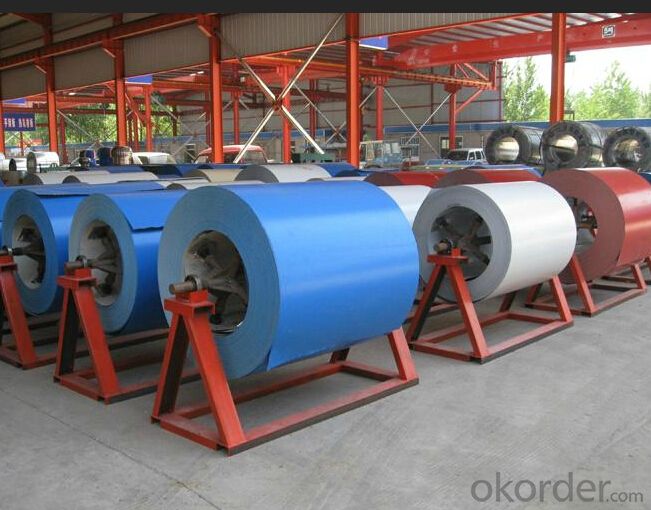
4.Prepainted Galvanized steel Coil Specification
Standard:ASTM, GB,JIS,JIS G3302 ASTM 755 EN10169
Grade: DX51D CGCC CS
Thickness: 0.13mm~3.0mm,
Width: 1250,600-1250mm
Coil weight:3-12 MT
Coil ID:508/610mm
Chemical composition:
C | Si | Mn | Cr | Ni | P | S |
0.150 | 0.476 | 11.231 | 12.50 | 0.900 | 0.039 | 0.010
|
5.FAQ of Prepainted Galvanized steel Coi
We have organized several common questions for our clients,may help you sincerely:
1.How do you control your quality
We have established the international advanced quality management system,every link from raw material to final product we have strict quality test;We resolutely put an end to unqualified products flowing into the market. At the same time, we will provide necessary follow-up service assurance.
2.how long we will receive the goods ?
After receiving your deposit or workable lc ,our normal shipment date is 15-20days,and it takes around 28 days to reach your port of destination. But is up to different destination
3. what is your moq
Normally our moq is 25per size ,but it is up to different size
- Q:What are the sectors in which galvanized steel strips can be used?
- Steel sheet galvanized steel strip is a kind of narrow and long steel plate produced by various steel rolling mills in order to meet the needs of industrial production of various metal or mechanical products in different industrial sectors. Strip steel, also called steel belt, is slightly different in length according to the size of each roll. The strip is supplied in general, and has the advantages of high dimensional accuracy, good surface quality, easy processing and material saving.
- Q:How do steel strips compare to steel sheets?
- Various industries utilize steel strips and steel sheets, which are both common forms of steel. However, they vary in terms of thickness, width, and application. Steel strips, being narrow and elongated, typically boast a thickness ranging from 0.2mm to 6mm and a width below 600mm. These strips find frequent use in precise applications, such as automotive components, electrical appliances, and construction materials. Their slender nature allows easy manipulation, enabling bending, forming, and cutting into specific shapes. Additionally, their narrow size makes them an ideal choice for weight reduction in crucial applications. Conversely, steel sheets are larger and flat pieces of steel, usually featuring a thickness between 0.6mm and 25mm and a width exceeding 600mm. Construction, shipbuilding, industrial machinery, and general fabrication widely employ steel sheets. Their structural strength and stability render them suitable for load-bearing purposes, including building frameworks, bridges, and heavy machinery. Although both steel strips and steel sheets share the same material, their differing dimensions and applications provide them with distinct utilities. Steel strips exhibit versatility, allowing intricate designs and precise manufacturing. On the other hand, steel sheets offer strength and stability for heavy-duty applications. Ultimately, the choice between steel strips and steel sheets depends on the specific project requirements and desired characteristics of the final product.
- Q:What are the different welding techniques used for steel strips?
- When welding steel strips, there are various techniques that can be employed depending on the specific application and desired outcome. 1. Arc Welding: A widely used method for welding steel strips involves creating an electric arc between an electrode and the workpiece. This technique can be further classified into different types such as shielded metal arc welding (SMAW), gas metal arc welding (GMAW), and gas tungsten arc welding (GTAW). Arc welding ensures a robust and long-lasting bond between the steel strips. 2. Resistance Spot Welding: This technique involves applying pressure and heat to specific points on the steel strips using electrodes. The electric current passes through the strips, causing them to fuse together. Resistance spot welding is particularly favored in the automotive and manufacturing industries due to its speed and efficiency. 3. Laser Welding: By utilizing a high-powered laser beam, this method melts and fuses the steel strips together. Laser welding offers precise control and minimal heat input, making it ideal for thin steel strips or applications requiring high precision. 4. Electron Beam Welding: Similar to laser welding, electron beam welding employs a focused beam of electrons to melt and join the steel strips. This technique is especially effective for welding thin strips or materials with high melting points. 5. Friction Stir Welding: This innovative technique involves a rotating tool that generates friction and heat between the steel strips, effectively joining them together. Friction stir welding is commonly used for aluminum and other non-ferrous metals but can also be adapted for steel strips. Each welding technique possesses its own set of advantages and limitations. The choice of technique depends on factors such as the thickness of the steel strips, desired strength, joint configuration, and production requirements. It is crucial to consider these factors and seek advice from welding experts to determine the most suitable technique for specific steel strip welding applications.
- Q:How are steel strips used in the production of tubes?
- Due to their strength and versatility, steel strips are widely used in tube production. The production process typically begins with a steel strip, which is slit into narrower strips to achieve the desired width and thickness for the tube. These narrower strips are then fed into a tube mill, where they are shaped into a cylindrical form. To achieve the desired tube shape, the steel strips are initially passed through a series of rollers that gradually bend and shape them. The configuration of these rollers varies depending on the specific requirements of the tube being produced. The strips are continuously welded along their length to create a seam, which is typically accomplished through high-frequency induction welding or electric resistance welding. Once the welding process is complete, the tube undergoes further processing to ensure it meets the desired specifications. This may involve additional shaping, such as cold forming or sizing, to achieve the required dimensions and tolerances. Additionally, the tube may undergo heat treatment or other finishing processes to enhance its strength, durability, or surface qualities. Steel strips are crucial in tube production as they serve as the raw material required to create the cylindrical shape. Their high strength and formability enable the production of tubes with precise dimensions and consistent quality. Moreover, steel is renowned for its excellent mechanical properties, making the resulting tubes suitable for a wide range of applications in various industries, including construction, automotive, and manufacturing.
- Q:How are steel strips used in the production of kitchen utensils?
- Steel strips are commonly used in the production of kitchen utensils as they are cut, shaped, and formed into various utensil components such as blades, handles, or frames. These strips provide the necessary strength, durability, and corrosion resistance required for kitchen utensils, ensuring they can withstand regular use and maintain their quality over time.
- Q:How are steel strips cleaned before further processing?
- To ensure the elimination of impurities and contaminants, steel strips undergo a multi-step process of cleaning. Initially, a mechanical cleaning process is employed, utilizing brushes or abrasive materials to scrub the surface and remove loose dirt, dust, and scale. Following the mechanical cleaning, a chemical cleaning process is implemented. This involves the use of a carefully selected chemical solution or acid bath to dissolve and eradicate stubborn contaminants like rust, oil, or grease. The choice of chemical solution depends on the specific type and nature of the contaminants present on the steel strips. Once the chemical cleaning is finished, the steel strips undergo a thorough rinsing with water to eliminate any residue from the cleaning solution. This step is crucial in order to prevent any potential impact on the quality of the final product due to residual chemicals on the surface. After rinsing, the steel strips are typically dried using various methods, such as air-drying or heat treatment, to ensure the complete removal of any remaining moisture. This is important for preventing rust or corrosion during subsequent processing and storage. In conclusion, the cleaning of steel strips prior to further processing is a vital step to guarantee the quality and integrity of the final product. By eliminating impurities and contaminants, the cleaning process enhances the performance, durability, and aesthetics of the steel strips, making them suitable for a wide range of applications in industries such as automotive, construction, and manufacturing.
- Q:How are steel strips used in the manufacturing of construction equipment?
- Steel strips are commonly used in the manufacturing of construction equipment as they provide strength, durability, and flexibility. These strips are often utilized for forming the structural framework, reinforcing components, or creating intricate parts that withstand heavy loads and harsh conditions. Additionally, steel strips can be bent, welded, or molded into various shapes, allowing manufacturers to tailor them to specific equipment requirements.
- Q:Can steel strips be used in marine environments?
- Yes, steel strips can be used in marine environments. However, it is important to consider the grade and corrosion resistance of the steel to ensure it can withstand the harsh conditions, such as exposure to saltwater and moisture. Additionally, proper maintenance and protective coatings may be necessary to prevent corrosion and prolong the lifespan of the steel strips in marine environments.
- Q:Are steel strips used in the production of oil and gas equipment?
- Yes, steel strips are commonly used in the production of oil and gas equipment. They are utilized for various applications such as manufacturing pipes, tanks, valves, and other components that require high strength, durability, and resistance to corrosion. Steel strips provide the necessary mechanical properties to withstand the demanding conditions of the oil and gas industry.
- Q:Are steel strips suitable for the production of cutlery or kitchen utensils?
- Yes, steel strips are suitable for the production of cutlery or kitchen utensils due to their durability, strength, and resistance to rust and corrosion.
1. Manufacturer Overview |
|
|---|---|
| Location | |
| Year Established | |
| Annual Output Value | |
| Main Markets | |
| Company Certifications | |
2. Manufacturer Certificates |
|
|---|---|
| a) Certification Name | |
| Range | |
| Reference | |
| Validity Period | |
3. Manufacturer Capability |
|
|---|---|
| a)Trade Capacity | |
| Nearest Port | |
| Export Percentage | |
| No.of Employees in Trade Department | |
| Language Spoken: | |
| b)Factory Information | |
| Factory Size: | |
| No. of Production Lines | |
| Contract Manufacturing | |
| Product Price Range | |
Send your message to us
Best Prepainted Galvanized steel Coil ASTM 615-009
- Loading Port:
- Tianjin
- Payment Terms:
- TT OR LC
- Min Order Qty:
- 111 kg/m²
- Supply Capability:
- 11 kg/m²/month
OKorder Service Pledge
OKorder Financial Service
Similar products
New products
Hot products
Related keywords
